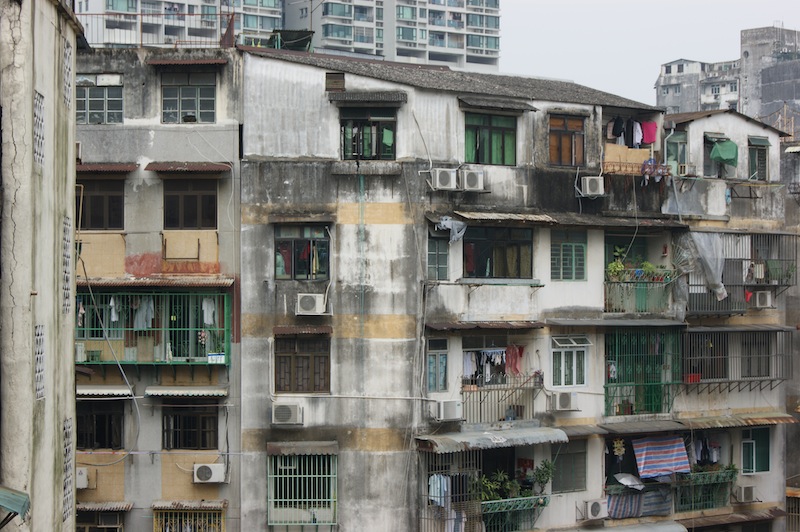The Macau we discovered on our first night in the city is modern, glitzy and built for tourists. Known as the Cotai Strip, it’s a stark contrast to the historic, atmospheric old town.
It has elegant and colourful Portugese influences from colonial times, while its streets are crowded with old apartment blocks, temples, shops and the rough and tumble of everyday Chinese life. It promised to be a fascinating mix of east and west.
We prepped ourselves for the day ahead with breakfast in our rooms at the Conrad Hilton. Decadent yes, but we had an upgraded suite to fill and, if it’s any consolation, the eggs benedict was disappointing. Without having to fight our way through crowds at the time-consuming breakfast buffet, it meant we could start the day early and get some serious sightseeing done. A cab took us the main island and the UNESCO World Heritage heart of old Macau, through the Cotai Strip and its forest of fancy hotels and casinos, building sites and cranes. There’s nothing remotely Chinese about the new Macau developments and we could’ve been anywhere on earth.

Beyond were more skyscrapers, most of them apartment complexes for workers. Some were modern, others in the process of being built, and a few looked as if they’d seen many better days. But they were all absolutely massive, in scale beyond anything I’d seen in the West.
We crossed the water and arrived at the famous A-Ma Temple ready for our walk, and discovered the crowds. The area was rammed with people, from devout locals to tourists with huge cameras. The stench of incense was overwhelming and Graham found himself struggling with his asthma while he snapped away on his new camera.
We moved on through the back streets, overlooked by creaky looking, aged apartment blocks. They were colourful in places but Macau’s humidity has played havoc with the rendering, much of which is afflicted with mould, algae or moss, and many of the metal balconies have rusted. It looks quite tatty, yet I found it surprisingly attractive and charming. Graham was taken aback at how poor and overdeveloped Macau is and it’s true that there’s precious room to spare, much like its near neighbour Hong Kong.

In between the hemmed-in blocks of flats and shops, the narrow streets lined with scooters and the posters advising against spitting and littering, there are occasional reminders of the city’s Portugese past. The Moorish barracks are a riot of yellow, while quiet and shaded Lilau Square is full of fine old buildings. There, locals out for a quiet morning of stretching and chatting were snapped by roaming bands of rather insensitive tourists. Nearby we found the grandly restored Mandarin’s House, a rambling collection of rooms and courtyards that made for a delightful break from the noise and bustle outside. Like all the attractions we visited in Macau, it was free to enter.
Our route took us past and into some impressive churches, St Lawrence’s and St Joseph’s to name but two. The picturesque St Augustine’s Square continued the trend of colonial buildings on a human scale, colourful and Mediterranean. There, we visited the small Dom Pedro V theatre and St Augustine’s Church.

Emerging from the quiet back streets, we found ourselves in the busy heart of the old town. Senado Square is colourful and exciting, dominated by the grand Leal Senado building. These days the square is overwhelmingly commercial and while we were there people milled around watching the Macau Grand Prix on a giant TV screen.
Shops are a mixture of familiar names from the west and local outfits. Bakeries and other take-aways fill the gaps, many of them selling a strange and rubbery, much-processed gloop that’s supposed to be meat and is clearly very popular with the locals. We steered clear but eateries were thin on the ground for lunch, at least places where we could sit for an hour. And I needed to sit. Lunch is on the go in Macau and we struggled to find anywhere that was suitable, plumping depressingly for Starbucks. I didn’t feel proud about it…

In the afternoon we visited the city’s premier tourist attraction, the ruins of St Paul’s Church, which was destroyed by a fire during a typhoon in 1835. Sure, standing on a hill they dominate the view but I’m not quite sure what the fuss is all about. So we wandered around the nearby fort and got some great views of the city across the rooftops, views that revealed a jumble of development, new and old, high and low-rise, some glam but most old and shabby. In the hazy distance, the towering blocks of modern China stood proud.
With my legs suffering, we moved on a little further and discovered a street of antiques shops and the Casa Garden and Protestant Cemetery, both of them quiet and green.
One quick cab ride later, back at the hotel, we grabbed a beer, got a late afternoon nap and then headed out. My tummy was struggling but we went for food at Canton, a lovely restaurant in The Venetian Hotel, where my diced pork was a real delight and the service excellent.
We’d opted to stay in the Cotai Strip because of the casinos and, to our deepest joy, we found a roulette table in one with a minimum bet of $25. Not that it stopped me from losing $500, although Graham broke even. The night also proved to be a very different experience to gambling in Vegas and London. Finding a beer is nigh-on impossible and the locals take it all so, so seriously. Baccarat is the game of choice with cash-laden Chinese and table after table is devoted to it. The few black jack tables had far too high a minimum bet for our wallets.
Before we crashed out, we grabbed a few more drinks back in the bar at the Conrad. And I nursed my broken bank balance…

